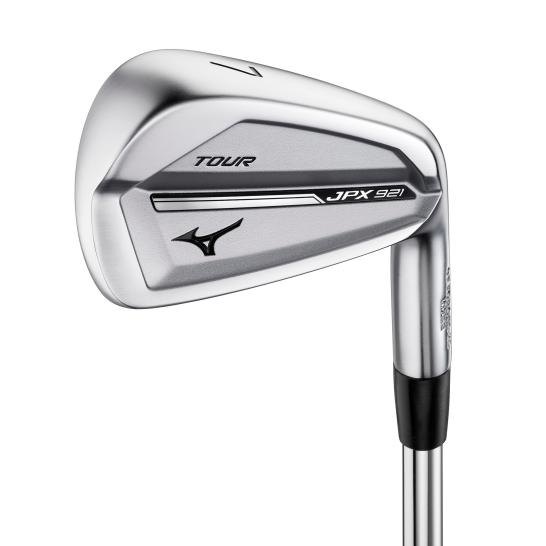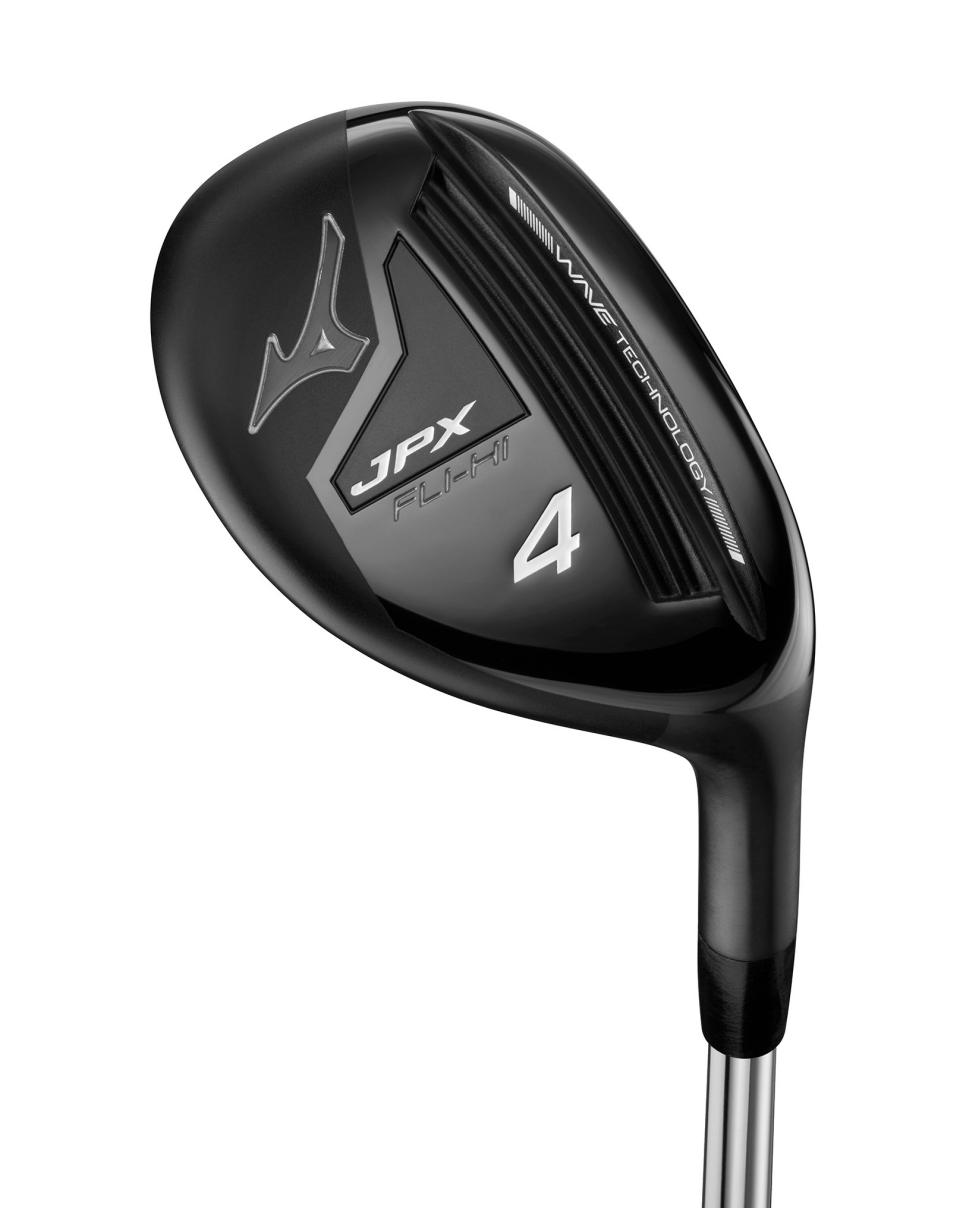There are not many companies, if any, that can introduce five sets of irons at one time – throw in a specialty set of long-iron replacement hybrids to boot – and still make you believe that each has its place. But that’s precisely what Mizuno has done with its next iteration of its modern JPX lineup.
The five branches of the new JPX 921 family run the gamut from tour-approved players muscle cavity to meat-of-the-market game-improvement model, but each grabs your attention not just for the style but also for their substance. That includes new uses for the extra-strong chromium-molybdenum-infused steel alloys (“Chromoly”) in both cast and forged varieties.
Most intriguing certainly has to be that latter iron, the JPX 921 Forged, what Mizuno’s David Llewellyn, senior vice president of research and development, described as “never seen in a one-piece forging.” The JPX 921 Forged updates the company’s approach to the player’s distance iron category by using the Chromoly steel alloy, which has been notably incorporated in both roll cages and M16 rifles. That strength creates a thinner, hotter face in a relatively compact better player’s shape. While its predecessor, the JPX 919 Forged, used a boron-infused 1025 carbon steel, the new metal in the JPX 921 Forged opened new doors, Llewellyn said. That includes a face that’s 16 percent thinner in the centre, a jump in coefficient of restitution (COR) and a 45 percent larger area that yields the fastest ball speeds compared to the JPX 919 Forged.
“Using this new material, when you go thinner on the face not only are you making the face hotter, you’re also moving the centre of gravity back, so we see a lower and deeper centre of gravity, particularly in your long irons,” Llewellyn said. “But even though the head got a little more compact we’re not really sacrificing anything in terms of MOI [moment of inertia, or stability on off-centre hits].
“Improving the launch, not giving up anything in terms of forgiveness and gaining a lot of ball speed, those all sound like good things to me.”
Using the Chromoly steel in a forged form required a more intense forging process with extra steps, as well as the back-milling technique behind the face that thins out a wider section for more distance potential.
“That added strength is what we needed,” Llewellyn said of the 4120 steel. “That allows you to go thinner on the face and increase your ball speed to increase your distance. But we wanted to maintain a one-piece grain flow forged feel, too. That’s very difficult.”
The JPX 921 Forged also pushed back towards some better player preferences including a thinner topline and a bevelled, narrower sole for improved shotmaking opportunities.

JPX 921 Forged is just one of the four new models with a nod to the players’ eye-friendly look. At the top of the skill pyramid is the JPX 921 Tour, a compact muscle-cavity blade. It follows on the heels of the successful tour rotation of the JPX900 Tour and JPX 919 Tour designs. Forged from Mizuno’s 1025E carbon steel, the JPX 921 Tour uses the company’s HD process from those past designs to concentrate the grain in the central hitting area for improved feel.
The updated JPX 921 Tour features slightly less toe-biased weighting than its predecessor but also improves the outer perimeter frame structure for stability. “What we’ve done is produce more efficient perimeter weighting while still having enough weight left over to reinforce the centre for a lower sound pressure that equates to a softer feel at impact,” Llewellyn said.
While all the company’s irons can be mixed and matched for combo set purposes, Mizuno’s team created a specific combo set to answer the left-handed market seeking that better players’ look, feel and performance. The JPX 921 SEL uses the JPX 921 Forged in the long irons and rounds out the majority of the set with JPX 921 Tour, making for the first left-handed JPX Tour iron since the series began in 2016.

Despite the breadth and well-known historical reputation in the forged iron business, the company’s biggest marketplace success in recent years has come with the JPX cast irons, bolstered by the use of the Chromoly steel alloy starting with the JPX 900 Hot Metal. The JPX 921 Hot Metal lineup includes an updated standard game-improvement model to go with the slightly compact, less offset JPX 921 Hot Metal Pro, both of which feature the high-strength steel alloy for thinner construction and faster ball speeds.
Llewellyn said the third generation of the Hot Metal irons makes for the thinnest, fastest face in company history, 2.2 millimetres at centre and as thin as 1.9 millimetres at the extremes. Introducing the Hot Metal and Hot Metal Pro together along with the JPX 921 Tour and JPX 921 Forged also allows for more clear distinctions between each, with the Tour set at the most compact, the Forged moving more toward shaping that suits the better player’s eye, while the Hot Metal and Hot Metal Pro each expand slightly while still remaining on the compact side of their respective categories.
What’s most important, though, is using the high-strength Chromoly steel alloy in a third-generation product yielded new freedoms, Llewellyn said.
“We know how aggressive we were in the past, and we know there wasn’t a durability issue, so now we can get even more aggressive,” he said. “The two examples here were being able to get both a thinner face and a variable sole geometry. The variable sole thickness heslp further spread out the stress distribution. The thin area at the leading edge acts as kind of a hinge to transfer some of that stress to the sole and allow the face to flex even more.”

Both the Hot Metal and Hot Metal Pro again feature a perimeter undercut cavity with updated ribs designed to support the frame for improved sound and feel. A degree stronger loft (29 degrees in the 7-iron, which is now in line with the marketplace’s range in the game-improvement iron category, also helps with the distance equation.
The JPX lineup goes one step further in answering the distance challenge by updating its FliHi hybrids, which are offered only as a custom replacement for long irons. Formerly featuring a drop-down shape to the crown, the JPX FliHi hybrids now use a more traditional crown that uses less mass up top to help lower the centre of gravity and thus help to increase launch. The JPX FliHi will be available in four lofts, replacing 4-iron through 7-iron (20, 22.5, 25 and 29 degrees).

“We see this as more of a precision hybrid because too many hybrids today don’t land and stop,” Llewellyn said. “This is about maintaining distance gaps, as opposed to maximising distance. These shots should travel the same distance as the iron they’re designed to replace, but get there in a different manner so they stay on the green for this player.”
The FliHi seems one more reflection of the broadest possible approach to the JPX 921 lineup, which has a model that can be played by a tour player and one that can be played by a tourist.
Australian pricing (per iron) is as follows: JPX 921 Tour: $279; JPX 921 SEL: $299; JPX 921 Forged: $299; JPX 921 Hot Metal and Hot Metal Pro: $239. The full lineup goes on pre-sale on August 31 and is scheduled to be available at retail September 18.



